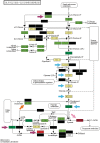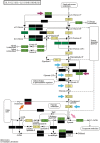KOMODO: a web tool for detecting and visualizing biased distribution of groups of homologous genes in monophyletic taxa
- PMID: 22675073
- PMCID: PMC3394310
- DOI: 10.1093/nar/gks490
KOMODO: a web tool for detecting and visualizing biased distribution of groups of homologous genes in monophyletic taxa
Abstract
The enrichment analysis is a standard procedure to interpret 'omics' experiments that generate large gene lists as outputs, such as transcriptomics and protemics. However, despite the huge success of enrichment analysis in these classes of experiments, there is a surprising lack of application of this methodology to survey other categories of large-scale biological data available. Here, we report Kegg Orthology enrichMent-Online DetectiOn (KOMODO), a web tool to systematically investigate groups of monophyletic genomes in order to detect significantly enriched groups of homologous genes in one taxon when compared with another. The results are displayed in their proper biochemical roles in a visual, explorative way, allowing users to easily formulate and investigate biological hypotheses regarding the taxonomical distribution of genomic elements. We validated KOMODO by analyzing portions of central carbon metabolism in two taxa extensively studied regarding their carbon metabolism profile (Enterobacteriaceae family and Lactobacillales order). Most enzymatic activities significantly biased were related to known key metabolic traits in these taxa, such as the distinct fates of pyruvate (the known tendency of lactate production in Lactobacillales and its complete oxidation in Enterobacteriaceae), demonstrating that KOMODO could detect biologically meaningful differences in the frequencies of shared genomic elements among taxa. KOMODO is freely available at http://komodotool.org.
Figures



Similar articles
-
Fragment of the aspartyl-tRNA synthetase applicable as a shared classification and phylogenetic marker in particular representatives of the order Lactobacillales.Folia Microbiol (Praha). 2019 Jan;64(1):113-120. doi: 10.1007/s12223-018-0638-8. Epub 2018 Aug 9. Folia Microbiol (Praha). 2019. PMID: 30094534
-
DEFOG: discrete enrichment of functionally organized genes.Integr Biol (Camb). 2012 Jul;4(7):795-804. doi: 10.1039/c2ib00136e. Epub 2012 Jun 18. Integr Biol (Camb). 2012. PMID: 22706384 Free PMC article.
-
GeneCodis3: a non-redundant and modular enrichment analysis tool for functional genomics.Nucleic Acids Res. 2012 Jul;40(Web Server issue):W478-83. doi: 10.1093/nar/gks402. Epub 2012 May 9. Nucleic Acids Res. 2012. PMID: 22573175 Free PMC article.
-
Evaluation of the infB and rpsB gene fragments as genetic markers intended for identification and phylogenetic analysis of particular representatives of the order Lactobacillales.Arch Microbiol. 2018 Dec;200(10):1427-1437. doi: 10.1007/s00203-018-1554-7. Epub 2018 Jul 23. Arch Microbiol. 2018. PMID: 30039323
-
GC-Profile: a web-based tool for visualizing and analyzing the variation of GC content in genomic sequences.Nucleic Acids Res. 2006 Jul 1;34(Web Server issue):W686-91. doi: 10.1093/nar/gkl040. Nucleic Acids Res. 2006. PMID: 16845098 Free PMC article.
Cited by
-
POTION: an end-to-end pipeline for positive Darwinian selection detection in genome-scale data through phylogenetic comparison of protein-coding genes.BMC Genomics. 2015 Aug 1;16(1):567. doi: 10.1186/s12864-015-1765-0. BMC Genomics. 2015. PMID: 26231214 Free PMC article.
-
Homology-independent metrics for comparative genomics.Comput Struct Biotechnol J. 2015 May 4;13:352-7. doi: 10.1016/j.csbj.2015.04.005. eCollection 2015. Comput Struct Biotechnol J. 2015. PMID: 26029354 Free PMC article. Review.
References
Publication types
MeSH terms
LinkOut - more resources
Full Text Sources
Medical

